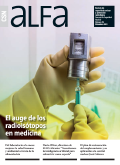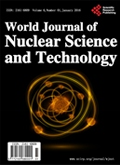 |
 |
 |
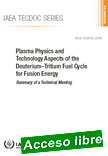 |
Plasma Physics and Technology Aspects of the Deuterium–Tritium Fuel Cycle for Fusion Energy
IAEA-TECDOC-2049 ¦ English ¦ Date published: 2024
This publication provides an overview of plasma physics and technology aspects of the Deuterium-Tritium fuel cycle in magnetic fusion devices, from ITER to demonstration fusion power plants. The TECDOC also provides contributed papers from experts representing a wide range of international magnetic confinement fusion research and development programmes working on the D-T fuel cycle.
|
This publication is intended for scientists and engineers working on fusion R&D, as well as private sector companies working in fusion energy development areas.
|
 |
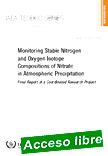 |
Monitoring Stable Nitrogen and Oxygen Isotope Compositions of Nitrate in Atmospheric Precipitation
IAEA-TECDOC-2050 ¦ English ¦ 44 pages ¦ Date published: 2024
This publication is a result of the Coordinated Research Project (CRP) F32008 "Global Monitoring of Nitrogen Isotopes in Atmospheric Waters" implemented by the IAEA’s Isotope Hydrology Section in 2018-2023. The CRP was focused on the determination of the spatio-temporal distribution of nitrogen isotopes in precipitation as a potential source of nitrogen pollution of water resources, especially of aquatic systems sensitive to eutrophication stressors.
|
The principal method was based on the combined application of nitrogen isotopes with atmospheric chemistry and hydrometeorological techniques to better understand wet deposition processes and to characterize the origin and transformations of inorganic nitrogen loadings. This publication was supported by specialists in isotope hydrology, atmospheric and water sciences from a range of different countries around the world. Examples of their isotope applications have been provided to give context to the guidelines and recommendations made by this publication.
|
 |
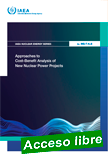 |
Approaches to Cost-Benefit Analysis of New Nuclear Power Projects
IAEA Nuclear Energy Series No. NG-T-4.8 ¦ English ¦ STI/PUB/2079 ¦ 100 pages ¦ Date published: 2024
Cost-Benefit Analysis (CBA) is an economic appraisal tool which can be used to inform an investment decision, for instance, the construction of a nuclear power plant. In a CBA, the costs and benefits are accounted for as fully as possible, allowing estimation of the net economic benefit associated with the project relative to a without-the-project scenario, or an alternative investment proposal.
|
This publication suggests an approach for conducting a CBA for a nuclear newbuild project as part of a feasibility study. It presents a CBA framework which is built around four key steps to characterize a project: the project’s objectives, alternatives to the project, and the broad context; a financial analysis, including estimates of costs and profitability; an economic analysis, taking a broader view to include additional benefits and costs to society; and a sensitivity and risk analysis to assign a confidence level to key financial and economic indicators and identify the circumstances in which the project will generate value. The publication includes a case study to illustrate the framework’s application and describes, for example, the methodology used for valuing environmental benefits, such as emissions and pollution reduction. The publication is aimed at all stakeholders involved in the planning and decision-making on a nuclear new build project.
|
 |
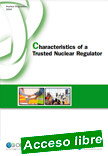 |
Characteristics of a Trusted Nuclear Regulator
Nuclear Energy Agency, OECD. ¦ English ¦ NEA No. 7618 ¦ 48 pages ¦ Date published: 2024
This report is intended to serve as a practical guide to explain the organisational characteristics, attributes and ways of thinking that can help a nuclear regulator build and maintain trust with interested stakeholders and the public. It offers examples of actions and activities that can be taken to demonstrate those characteristics in practice.
|
The NEA encourages and challenges all established regulatory bodies to use it as a benchmark so that they continually strive to enhance their effectiveness in fulfilling their mission to protect people and the environment. It aims to be a resource for countries with existing, mature regulators, but can also be used for training and developing staff in newcomer countries currently in the process of developing and maintaining a trusted nuclear safety regulator.
|
 |
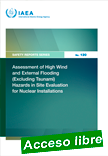 |
Assessment of High Wind and External Flooding (Excluding Tsunami) Hazards in Site Evaluation for Nuclear Installations
Safety Reports Series No. 120 ¦ English ¦ STI/PUB/2006 ¦ 131 pages ¦ Date published: 2024
In recent years, significant experience of the effects of high wind and flooding on nuclear installations has been gained worldwide. These phenomena may simultaneously affect all the structures, systems and components important to safety at a nuclear installation site. By detailing the methodologies and providing case studies for the evaluation of meteorological and hydrological hazards, this publication supports IAEA Safety Standards Series No. SSG-18, Meteorological and Hydrological Hazards in Site Evaluation for Nuclear Installations.
|
In the first part of the publication, wind hazards relating to tropical cyclones, tornadoes, extratropical storms, thunderstorms and wind-borne debris are discussed. The second part covers external flooding hazards (excluding tsunamis) relating to wind induced coastal flooding, wind generated waves on rivers, extreme precipitation and runoff events and the sudden release of impounded water.
|
 |
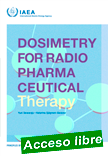 |
Dosimetry for Radiopharmaceutical Therapy
English ¦ STI/PUB/2065 ¦ 299 pages ¦ Date published: 2024
In this publication the basic principles of radiation physics, imaging and non-imaging instrumentation used, measurement of the administered activity, calibration procedures and methods for obtaining quantitative information on the biodistribution of the radioactive drug to be used with radioisotopes relevant to therapy are specified.
|
. It also describes methods for segmentation and registration of images acquired at different time points, strategies for fitting and integration of activity measurements over the time of treatment, absorbed dose calculations and derived dosimetric indexes with methods to estimate the overall uncertainty of different radionuclide therapies. The aim of this book is to fill the existing gaps in education and training of medical physicists on methods for patient-specific dosimetry. The overall objective of this book is to highlight the tools and methodologies to assure that radiopharmaceutical therapy is implemented through a dosimetry-guided individualized treatment approach.
|
 |
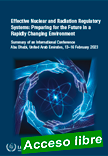 |
Effective Nuclear and Radiation Regulatory Systems: Preparing for the Future in a Rapidly Changing Environment
Summary of an International Conference Held in Abu Dhabi, United Arab Emirates, 13–16 February 2023
English ¦ STI/PUB/2087 ¦ 72 pages ¦ Date published: 2024
This publication provides a summary of the International Conference on Effective Nuclear and Radiation Safety Regulatory Systems - Preparing for the Future in a Rapidly Changing Environment, including the opening and closing remarks, and summaries of all technical sessions and panels and summaries of side events.
|
The conference served as a forum for identifying strategies to ensure regulatory resilience in a rapidly changing environment and to overcome life cycle challenges of nuclear installations and of activities involving radiation sources. It also focused on strengthening international cooperation and information sharing to improve regulatory effectiveness, agility and consistency in regulatory approaches related to new technologies. The major themes of the conference covered methodologies to increase public and stakeholder trust and regulatory credibility, best practices to sustain a competent workforce and develop the next generation of regulatory professionals and leaders, and programmes and strategies for the safe and secure use of radioactive material. This publication is intended for government ministers; senior officials and policymakers responsible for nuclear and radiation safety regulation; representatives of international, intergovernmental and non-governmental organizations (NGOs) with relevant competencies; regulatory bodies and other national competent authorities; and industry and other entities engaged in activities relevant to nuclear and radiation safety.
|
 |
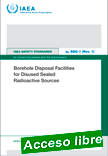 |
Borehole Disposal Facilities for Disused Sealed Radioactive Sources
IAEA Safety Standards Series No. SSG-1 (Rev. 1) ¦ English ¦ STI/PUB/2057 ¦ 152 pages ¦ Date published: 2024
This Safety Guide provides recommendations on the safe disposal of disused sealed radioactive sources in borehole disposal facilities. Sealed radioactive sources are used all over the world for a wide range of purposes, in areas such as health, industry, research and agriculture.
|
These sources are usually managed safely while in use, but States often experience challenges in their management once the sources reach the end of their useful lives. Even though they may no longer emit sufficient radiation for their intended purpose, disused sources are radioactive and potentially hazardous, and they need to be managed as radioactive waste. Written for regulators and others involved in the development and management of borehole disposal facilities, the objective of this Safety Guide is to provide recommendations on the commissioning, operation, closure, institutional control and regulation of borehole disposal facilities for disused sealed radioactive sources, and small volumes of low and intermediate level secondary waste generated during the management of these sources. This Safety Guide can also be used as a basis for reassessing and, where appropriate, upgrading the safety of existing borehole disposal facilities.
|
 |
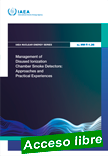 |
Management of Disused Ionization Chamber Smoke Detectors: Approaches and Practical Experiences
IAEA Nuclear Energy Series No. NW-T-1.26 ¦ English ¦ STI/PUB/2083 ¦ 87 pages ¦ Date published: 2024
Ionization Chamber Smoke Detectors (ICSDs) contain relatively small amounts of radioactive material and pose little hazard on an individual basis, even when disposed of in municipal landfills. However, many Member States have taken the decision to collect all or many of their country's disused ICSDs in one or more locations.
|
This often leads to the need for ICSDs to be managed as radioactive waste. The objective of this publication is to provide an overview of the management options for the ICSDs declared disused. It presents information on a variety of ICSD models. The approach and examples for landfill disposal of household ICSD, as consumer products exempted from regulatory control is discussed. It presents the management options for disused ICSD once they have been collected. Various options for the safe management of disused ICSDs are covered including advantages and disadvantages, based on Member State infrastructure and IAEA guidance and international safety standards.
|
 |
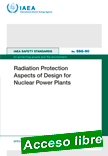 |
Radiation Protection Aspects of Design for Nuclear Power Plants
IAEA Safety Standards Series No. SSG-90 ¦ English ¦ STI/PUB/2078 ¦ 161 pages ¦ Date published: 2024
This Safety Guide provides recommendations for ensuring radiation protection in the design of new nuclear power plants, design modifications to operating plants, and checking the adequacy of the radiation protection aspects of design at different stages in the lifetime of operating plants.
|
It also provides recommendations for measures to be taken in the design for the protection of site personnel, the public and the environment, and outlines the methodologies used to calculate on-site and off-site radiological conditions and to verify that the design provides an adequate level of radiation protection during operating lifetime and decommissioning. The guide is intended primarily for land-based, stationary nuclear power plants with water cooled reactors designed for electricity generation or for other heat generating applications. This publication is intended for organizations responsible for designing, manufacturing, and constructing nuclear power plants, operating organizations and contractors, including plant operators who are involved in planning, managing and implementing the design and design modification of nuclear power plants, and regulatory bodies and technical support organizations.
|
 |
| |
|
|

|
|
|
| |
|
|
| |
| |
|
|
| |
| |
|
|
| |
| |
|
|
|
| |
| |

